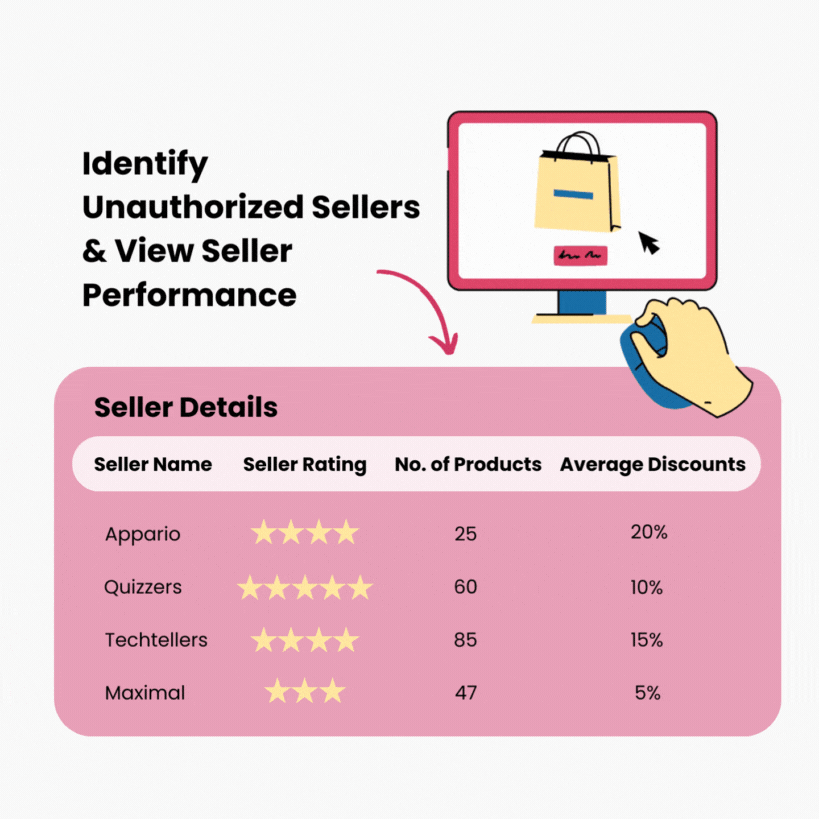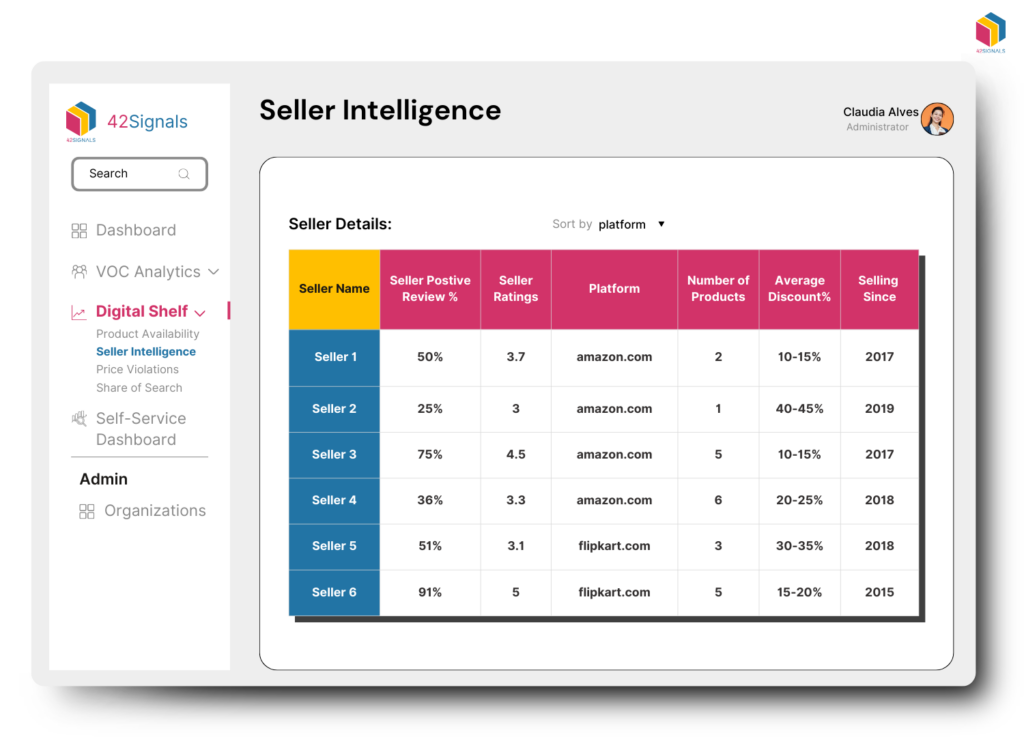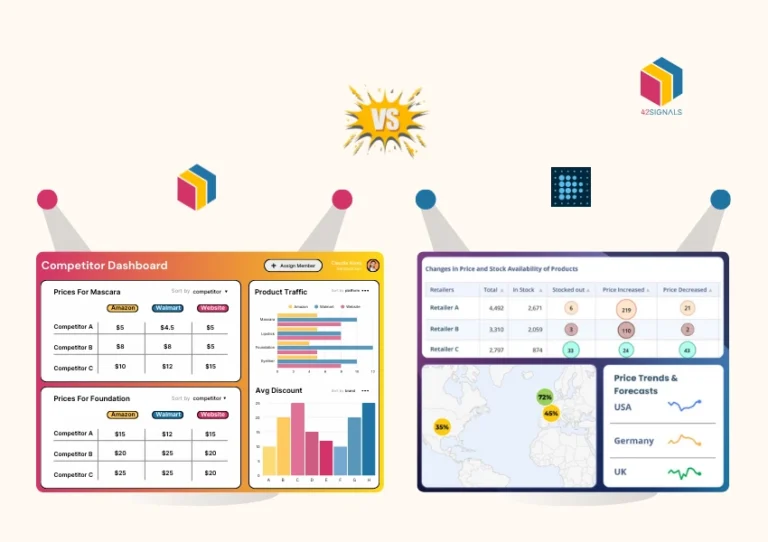Table of Contents
ToggleUnderstanding seller performance and compliance with Minimum Advertised Price (MAP) policies is crucial for maintaining brand integrity and market competitiveness for every e-commerce business. Seller intelligence, leveraging data analytics to monitor and evaluate seller activities, can provide valuable insights into top-performing sellers and those violating MAP policies.
This article delves into the significance of seller intelligence, the characteristics of top-performing sellers, and the impact of MAP violations.
What is Seller Intelligence?

Seller intelligence refers to the process of gathering, analyzing, and interpreting data about sellers within a specific marketplace. This intelligence can include a variety of metrics such as sales performance, pricing strategies, customer reviews, and compliance with pricing policies like MAP. By leveraging seller intelligence, businesses can make informed decisions that enhance their competitiveness and profitability.
Why is Seller Intelligence Crucial for Business Success?
Seller intelligence involves collecting and analyzing data related to sellers’ activities, pricing strategies, and overall performance. This intelligence helps brands and retailers:
1. Monitor Seller Performance with Seller Intelligence
Understanding which sellers are making the biggest impact on your brand’s sales is key to long-term growth. By leveraging seller intelligence tools, you can track performance metrics, identify top-performing sellers, and recognize those who consistently meet or exceed expectations.
This data allows you to build stronger partnerships with high-value sellers while addressing any underperforming ones to ensure your brand remains competitive in the marketplace.
2. Enforce MAP Policies
Maintaining consistent pricing across all sales channels is crucial for brand integrity and retailer relationships. With automated MAP (Minimum Advertised Price) monitoring, you can quickly detect violations and take action to address them—whether it’s sending warnings to sellers or enforcing penalties for repeat offenders.
Keeping pricing in check not only helps maintain healthy profit margins but also ensures fair competition among your retail partners.
3. Enhance Customer Experience
Your customers’ experience is directly influenced by the quality of sellers representing your brand. By working with reputable and reliable sellers, you can ensure that products are delivered on time, accurately described, and backed by excellent customer service.
Monitoring seller performance with seller intelligence also helps weed out those engaging in poor practices, such as shipping counterfeit products or failing to meet customer expectations, thereby protecting your brand’s reputation and customer trust.
4. Optimize Marketing Strategies
A data-driven marketing approach can significantly improve your return on investment. By analyzing seller performance metrics, you can refine your marketing strategies to target the most successful sellers and sales channels.
Whether it’s adjusting ad spend, creating tailored promotions, or reallocating resources to high-performing platforms, using seller data ensures your marketing efforts are both efficient and impactful, ultimately driving more sales and strengthening your brand’s presence.
What are the Characteristics of Top-Performing Sellers?
Top-performing sellers exhibit certain characteristics that set them apart from the rest. Understanding these traits can help brands foster successful partnerships and drive sales growth.

1. Competitive Pricing
Top sellers balance competitive pricing with adherence to MAP policies. They understand the importance of maintaining brand value while attracting customers with fair prices.
2. High-Quality Listings
Effective product listings with detailed descriptions, high-quality images, and accurate specifications enhance customer trust and boost sales.
3. Positive Customer Feedback
Excellent customer service and product quality result in positive reviews and high ratings, which are crucial for building a reputable seller profile.
4. Efficient Inventory Management
Successful sellers maintain optimal inventory levels, ensuring product availability while avoiding overstocking and stockouts.
5. Effective Marketing Strategies with Seller Intelligence
Top sellers invest in targeted marketing campaigns, leveraging SEO, social media, and paid advertising to reach their target audience.
6. Higher Conversion Rates
Top-performing sellers excel in converting visitors into customers. They achieve this through user-friendly website designs, clear calls to action, responsive customer support, and tailored promotions that encourage purchases.
How do MAP Violations Affect Brand Reputation and Sales?
Minimum Advertised Price (MAP) policies are established by brands to prevent price erosion and maintain a level playing field among sellers. However, MAP violations can have significant negative consequences.
1. Price Wars
MAP violations often lead to price wars, eroding profit margins and devaluing the brand. This can result in a race to the bottom, where sellers continuously undercut each other.
2. Brand Dilution
Consistent pricing across all channels reinforces brand value. MAP violations create inconsistencies that confuse customers and dilute the brand’s perceived value.
3. Unfair Competition
Sellers who violate MAP policies gain an unfair advantage over compliant sellers, leading to resentment and potential loss of reputable sellers.
4. Customer Distrust
Price discrepancies can erode customer trust. When customers find significant price variations for the same product, they may question the brand’s reliability and authenticity.
Using Seller Intelligence to Address MAP Violations

Using seller intelligence to address MAP violations involves leveraging advanced tools and data analytics to monitor and enforce pricing policies effectively.
Real-time monitoring capabilities allow automated tools to continuously track seller prices across various channels, providing brands with immediate alerts to potential MAP violations.
This proactive approach ensures that brands can quickly identify and address pricing discrepancies. Additionally, data analytics play a crucial role in identifying patterns and trends in MAP violations, enabling brands to understand the root causes and implement preventive measures.
Armed with detailed seller intelligence data, brands can take appropriate enforcement actions such as issuing warnings, suspending violators, or even terminating partnerships with repeat offenders. Collaborative efforts with top-performing sellers can further reinforce the importance of MAP compliance, fostering a cooperative approach to maintaining pricing integrity.
By utilizing these strategies, businesses can ensure a fair and competitive online marketplace, protect brand value, and enhance customer trust.
Introducing 42Signals: Revolutionizing Seller Intelligence
42Signals is an e-commerce analytics platform designed to provide comprehensive seller intelligence by monitoring various aspects of seller behavior, including MAP compliance. Here’s how it works:
1. Data Collection
42Signals uses advanced web scraping techniques to gather data from a wide range of e-commerce platforms. This data includes seller information, product listings, prices, and customer reviews.
2. Data Analysis
The platform employs sophisticated algorithms to analyze the collected data, identifying patterns and trends. This analysis helps distinguish top-performing sellers from those who violate MAP policies.
3. Reporting and Alerts with Seller Intelligence
42Signals generates detailed reports that highlight the performance of different sellers. The platform also provides real-time alerts for MAP violations, enabling businesses to take swift corrective actions.
Conclusion on Seller Intelligence
Seller intelligence is an invaluable asset for brands and retailers in the e-commerce landscape. By understanding the characteristics of top-performing sellers and addressing MAP violations, brands can maintain pricing consistency, enhance customer trust, and drive sustainable growth.
Leveraging data analytics and real-time monitoring tools, businesses can navigate the complexities of the online marketplace, ensuring a fair and competitive environment for all sellers.
Ready to see 42Signals in action?
Schedule a demo now to discover how our platform can help you protect your brand and boost your sales performance.
Frequently Asked Questions
What is seller intelligence?
Seller intelligence refers to the use of data-driven insights to help sellers optimize their pricing, product listings, and sales performance on e-commerce platforms like Amazon, eBay, and Shopify. It includes:
- Competitor analysis – Tracking competing sellers’ prices, stock levels, and promotions.
- Demand forecasting – Predicting market trends to stock high-demand products.
- Advertising optimization – Adjusting PPC (Pay-Per-Click) ads based on sales performance.
- Customer insights – Understanding buyer behavior to improve conversions.
What does sales intelligence mean?
Sales intelligence refers to the process of collecting and analyzing data to improve sales strategies, prospecting, and customer engagement. It helps businesses:
- Identify high-value leads and target audiences.
- Track customer buying behavior and preferences.
- Use AI-driven insights for personalized marketing.
- Optimize B2B sales strategies with CRM tools like Salesforce, HubSpot, or ZoomInfo.
What are the four types of market intelligence?
Market intelligence is crucial for understanding industry trends and customer preferences. The four main types are:
- Competitive Intelligence – Analyzing competitor pricing, marketing, and product positioning.
- Product Intelligence – Assessing product performance, quality, and customer reviews.
- Customer Intelligence – Gathering data on customer demographics, behavior, and purchasing trends.
- Market Understanding – Evaluating market size, growth opportunities, and industry trends.
What are the 7 P’s of competitive intelligence?
The 7 P’s of Competitive Intelligence help businesses analyze and outperform competitors:
- Product – Understanding competitor product quality, features, and innovation.
- Price – Monitoring competitor pricing strategies.
- Promotion – Analyzing competitor marketing and advertising tactics.
- Place – Examining distribution channels and retail strategies.
- People – Studying competitor leadership, hiring trends, and customer service.
- Performance – Tracking financial data, revenue growth, and market share.
- Process – Understanding operational efficiencies and supply chain management.
How can businesses use seller and sales intelligence?
- E-commerce sellers use tools like Helium 10 (Amazon sellers) or Jungle Scout to track competitor products.
- B2B sales teams leverage sales intelligence tools (LinkedIn Sales Navigator, ZoomInfo) to identify leads.
- Retailers and brands analyze customer sentiment and competitor strategies to optimize pricing and marketing.
What are the best tools for market intelligence?
- Google Trends & SEMrush – Track search demand and competitor rankings.
- Crunchbase & CB Insights – Monitor industry trends and funding data.
- SimilarWeb & NielsenIQ – Analyze web traffic and consumer insights.







